A Feed Sack Fabric Collecting Guide (History & Values)
If you’ve shopped for fabric lately, you know how expensive it can be. The same held true for shoppers during the Depression. But with some ingenuity and a bit of patience, housewives during that era sewed pretty remarkable household goods from feed sack fabric.
Feed sacks, also known as flour sacks, cotton bags, or “cotton commodity bags,” held grain, seed, fertilizer, flour, and other farm and kitchen supplies.
You may be familiar with homey quilts made with feed sack fabric, but many are surprised to learn that they were used by frugal housekeepers to sew dresses, aprons, and even underclothes(!).

Table of Contents
History Of Feed & Flour Sacks
Feed Sack Projects
Time Line of Feed Sack Usage
Feed Sack Values
Cleaning Musty Fabric
What Are Feed or Flour Sacks?
Feed or flour sacks are bags of various sizes made of fabric for the purpose of holding “commodities” like feed, grain, seed, flour, and sugar. Early on, manufacturers constructed them out of rough fabrics like burlap, but over time softer materials, specifically cotton, came into fashion.
The terms “feed sack” and “flour sack” are often used interchangeably, despite their referring to different types of commodities. As a result, researchers tend to refer to them with the generic term “commodity bags.”
Early History of Feed & Flour Sacks

At some point in the late 1800’s, sellers of flour and other commodities began to offer their goods in rough fabric bags, leaving the wooden barrel behind.

By about 1910, they began to use softer fabric, making it ideal for thrifty homemakers to fashion curtains, sheets, and sometimes clothing (Helen’s Closet).
In a comment on a National Museum of American History article about feed sacks, Barbara explains that her grandmother “had a slip made out of a flour sack. Across the rear end was printed 100 lbs net weight.”
There was no escaping a company’s logo in these early days!

Eventually, sack manufacturers became more creative with their label designs and once they realized that families made and wore clothing from their bags, they began to use printing inks that would easily wash out.
History of Printed Cotton Feed Sacks
This post contains affiliate links for materials related to this article. This is both for your convenience as well as to support this website, as I receive a small compensation whenever you click on such a link and make any sort of a purchase, for which I thank you. See my full disclosure here.
Invention of Printed Cotton Sacks

A young man named Asa Bales, working for the Plant Milling Co. of Missouri, “invented” the idea to use tiny checked gingham fabric (“dress goods”), in lieu of burlap and other rough fabrics.
In fact, the US government awarded him a patent on December 21, 1926; it included details about printing a company’s logo on the bag using dyes that would disappear in the wash.

The text of the patent application describes this new type of sack: “The sack of dress goods is, of course, of a size suitable of being remade into clothing. Preferably the dress goods is of a character known as gingham which is usually a cotton cloth having stripes or checks in two or more colors formed by yarn which is dyed variously before it is woven in order to provide the pattern.”
Wide-Spread Use

Other bag manufacturers, like the Percy Kent (NY) and Bemis (TN) companies, made the switch from plain bags to pretty calico-type designs.
In fact, some hired European and New York designers to develop attractive prints (Flashbak), hoping to entice women to choose their bags over competing brands. Today you can find feed sack fabric in thousands upon thousands of designs.
Floral patterns reigned but over time, seamstresses found animal, western, and historical designs to choose from.

Paper labels replaced inked on branding information making life much simpler for home sewers.
The Depression
Pretty feed sack fabric proved to be a life saver for many families during the Depression. With so many suffering from the financial crash and its affects, free (or low cost) feed sacks provided clothing for millions in desparate need.
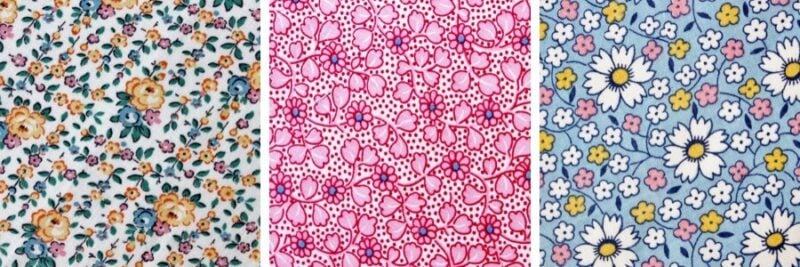

A 100 lb feed sack could be opened to create a yard of 44″ fabric–enough for a child’s dress, and about 3 pieces make an adult size garment.
In order to accumulate enough pieces of fabric, homemakers had to rely on their husbands to pick out the correct print when they went to town to buy feed, grain, or flour.
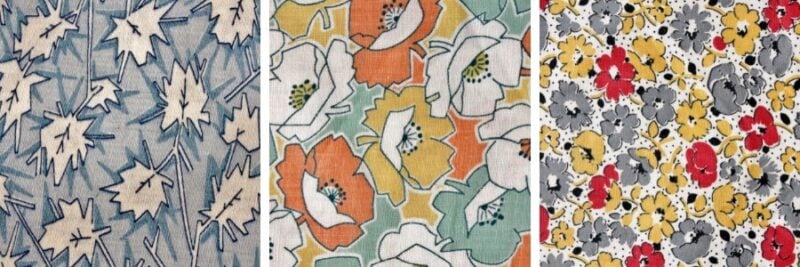

Alternatively, they could join their spouses and make their own choices. Another comment from the article in Helen’s Closet demonstrates this:
My Dad would holler from the garage door, “going into town to buy feed,” and we all three , Mom, my brother and me, would scurry out and hop in and away we went. We had feedsack pajamas, even Dad, dresses, shorts, blouses, shirts, hair bands, eyeglass cases even sheets and pillowcases.
Helen’s Closet
Feed Sack Projects

At the height of feed sack popularity, guides for sewing projects like dresses, shirts, aprons, quilts, and stuffed toys, became available. Newspapers and magazines also printed patterns for a variety of different projects over the decades of feed sack availability.
Feed Sack Aprons


Quilts
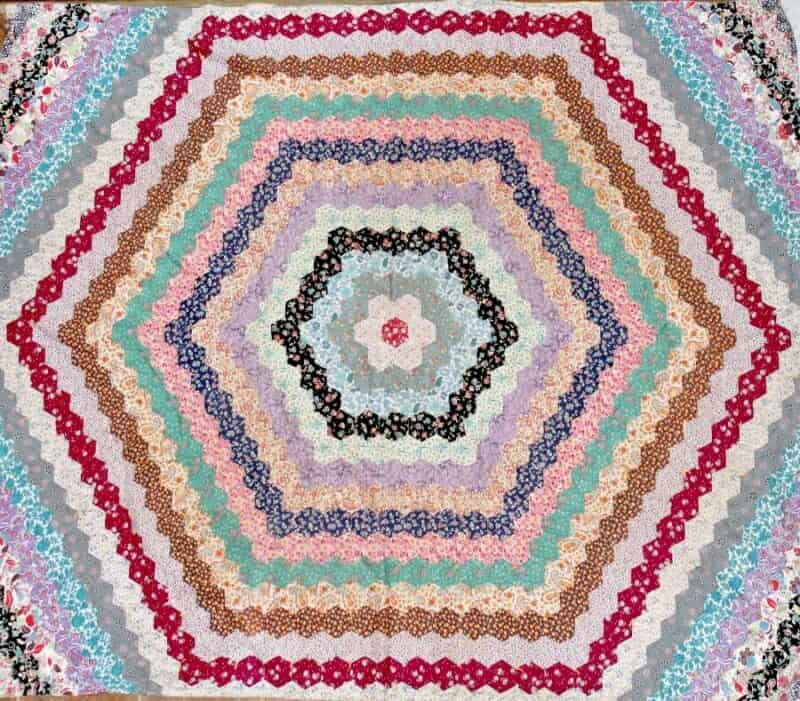

Toys
In addition, bag manufacturers began to print cut-out projects, like aprons and stuffed dolls directly onto the bags themselves.

Keeping the Fabric Feed Sacks Alive
By the 1950’s paper sacks became a less expensive means of containing the various commodities that had previously been stored in fabric bags.

The National Cotton Council, in an attempt to entice sellers of those commodities to continue using their fabric sacks, began to hold competitions at state fairs around the country and crown “National Cotton Bag Sewing Queens” (From Feed Sack to Clothes Rack).
In the 1960’s cotton bag manufacturers attempted to prolong sack popularity by printing fabrics with colorful cartoon characters, like Mickey Mouse and Snow White (Flashbak). Alas this did not have the desired affect.

By the end of the decade, the paper sack had replaced the beautiful and functional fabric sack.
Feed Sack Time Line
- Late 1800’s: Rough fabric sacks of linen and burlap replace barrels
- 1920’s: Softer cotton fabrics with company logos become prevalent
- 1930’s: Charming printed fabrics developed, used during the Depression for clothing
- 1940’s: Fabric scarcity due to WWII leads to increased use of feed sack fabric for clothing.
- 1950’s: Cheaper paper sacks introduced; National Cotton Council sponsors sewing contests.
- 1960’s: Fabric bag manufacturers add TV characters to prints to save their industry.
- Late 1960’s: Paper sacks replace fabric sacks
Where to Find Feed or Flour Sack Fabric
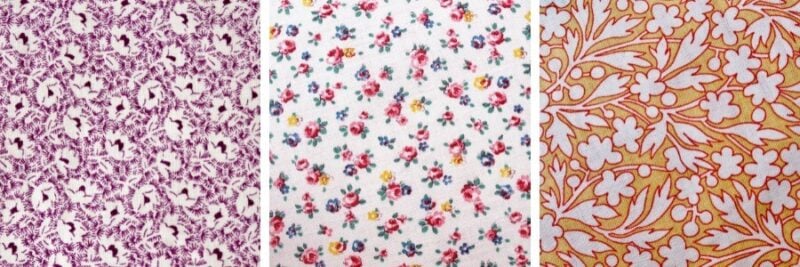
Feed sacks and feed sack fabric are not easy to find for resale. I have only had luck finding it priced low enough for resale, at estate sales. It tends to be at the bottom of piles of fabric, often stored in antique chests. So be sure to dig deep in whatever receptacle you see fabric. You never know what lies at the bottom…
If you’re looking for feed sacks and/or feed sack fabric, both eBay and Etsy make excellent choices. You will find quite a large selection on both, but typically at retail prices (of course).
Modern Feed Sack Books, Fabric, & Pillows
If you are looking for references about feed sacks, I’ve linked to a couple below, along with some reproduction fabric and some attractive feed sack pillows.

- Feed Sacks by Linzee Kull McCray (a feed sack authority)
- Reproduction feed sack fabric (10 fat quarters)
- Food Sacks, Vol. I by Tricia Maloney

Values & Where to Sell Feed Sack Fabric
You can find feed sacks and items made with the fabric in quite a startling wide price range. The sacks themselves can yeild prices in the $30-50 range for whole sacks.
Dresses current sell on eBay for $50 and up, while aprons run about $10-25 each. Quilts in very good to excellent condition, on the other hand, can be found for $150 to $300+.
I’ve had excellent luck selling feed sack fabric and related items from my Etsy shop. In fact, I’ve sold not only yards of fabric, but scraps as well, along with some quilted squares and partial projects.








How to Clean Musty Fabric
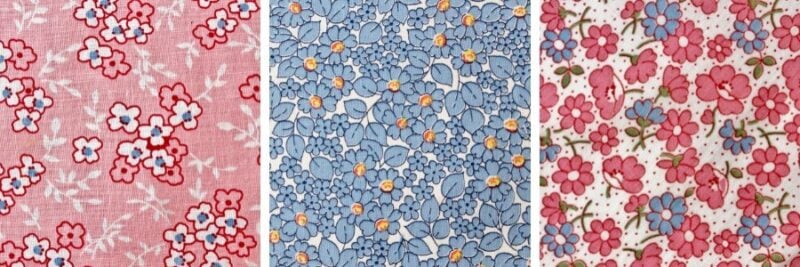
1. Sprinkle With Baking Soda
The least invasive method of removing smells from fabric involves (1) placing the piece in a plastic bag, (2) sprinkling in some baking soda, and (3) letting it sit for a few days or a week.
After the baking soda has had time to perform its magic, unseal the bag, shake out the baking soda and give the fabric a sniff.
If the smell remains, give the process another try, or consider using one of the methods below.
2. Set Out in the Sunshine
Lay the fabric out in the sunshine, preferably on grass (yes, this helps!), keeping an eye on it to ensure that the fabric doesn’t fade. A few hours, even one day, should not cause lightening.
3. Soak
Try soaking the fabric in water alone, changing the water as it becomes dark with whatever’s making it smell. Continue until the water is perfectly clear. Allow the fabric to dry and then give it the sniff test.
If the fabric continues to smell, add a mild detergent, like liquid castile soap or Dawn spray dish detergent and allow it to soak.
If the mild detergent doesn’t work, consider soaking in a stronger product, like borax or OxyClean. (Follow the directions on the product.)
How to Display or Use Feed Sacks
I’ve already mentioned how feed and other sacks were used “back in the day,” but how are modern decorators using them? Here are a few ideas:
- Frame them
- Sew pillow covers or seat pads
- Create tote bags
- Sew Christmas stockings
- Recover benches or dining room chairs
- Hang with cafe clips for no-sew curtains
- Cut & sew into towels
Conclusion
I hope you enjoyed learning about the history and values of feed sack fabric, and I trust that it will help you as you seek to grow your antique biz (or enlarge your collection).
Let me know your experience with feed/flour sack fabrics in the comments below. I’d love to hear your story.
Bye for now,

Thanks for stopping by–
If you enjoyed this post, subscribe today
and get a FREE copy of my eBook:
I’d love it if you’d pin me!



It must have been quite a feat to find enough matching sacks to make a woman’s dress!
My mother always wore feed sack clothes when she was growing up on the farm in Iowa. She has often told me how she and her sisters would beg their dad to hurry to the feed store, when a new shipment of sacks came in, so he could select the prettiest colors and get enough of one print to make a whole dress. I recognize many of the prints shownin your article.
Mom recently gave me the remaining feed sack material she has kept all of these years. She will be 94 in May. I treasure her stories and plan to keep the fabric forever.
Thanks so much for sharing your feed sack stories with us Kathy. What a tremendous blessing that you now have such a special momento of your mom 🙂
I learned to sew in my 8th grade home economics class in 1972. We were still purchasing feed for pigs and chickens in cotton sacks. I made kitchen curtains for my mom and lots of dresses and short sets for my sister and I throughout the early 70s. We lived in Southwest Virginia.
That’s all so fascinating to hear Susan, especially since all the resources I found indicated that they stopped making the pretty cotton sacks in the 60’s. It’s so neat that you had the experience of working with some sacks bought for your own farm animals 🙂
I volunteer at historic Arthurdale (Eleanor Roosevelt’s Little Village) outside of Morgantown WV. In our original house, we have a display of feed sacks plus a girl’s dress and the beginnings of a quilt top made from scraps. I’ve collected a fair number of fabrics and a couple well used quilts quite reasonably over the years in northern WV and western PA. We collected oral histories and many homesteaders tell stories about their clothing made from them. It’s a fascinating topic.
It is, isn’t it Jeanne? Thanks for sharing your experiences with historic preservation and feed sacks. Your house museum sounds fascinating. I’d love to visit some day 🙂
Great post, Diana! Pinned:)
Thanks Lora! I saw you had an interesting article on the same topic 🙂
Excellent article for a glimpse into the past…
Aww, thanks so much Jerri! So glad you enjoyed it 🙂
I wore feed sack dresses in the early to late 50’s. I had other ones as well. My grandmother did not make a pattern, she just held the fabric up against me and put in a few pins, then cut out a simple sundress with pockets and sashes.
I was very very thin, and she always gathered the fabric more for me. She had a treadle Singer machine, but when I was very small, she just made them by hand sewing. She also made aprons, doll clothes, and used scraps for the ends of pillow cases for decoration.
In 9th grade in 1965, I made my first apron in home economics in school on a treadle machine, cause no one else wanted to try it. Mother wouldn’t let me hers, though I wanted to. She always said when I was older I could. The instructor taught me how on the treadle machine and my mother was so surprised when I brought home that apron and told her I made it on a treadle Singer!
Thanks for the stirring of wonderful memories Diana.
What wonderful stories Dale! Thanks for sharing your real-life feed sack experiences along with your tale of learning to sew on a treadle Singer 🙂
I just purchased 75 small feed sack bags at an estate sale. $60! It even included 2 of the fabrics shown in the article photos.
That’s amazing Sharon!! You go girl 🙂
I have about 15 full size feed sacks remaining from those that I opened and fed the cows from in the late 1950’s/early 1960’s. When I was growing up, Mom and Grandma made many items from feed sacks including quilts, dresses, and shirts for me and my brothers.
My wife made me a blanket from some of them and that is the only blanket that the toy poodles cannot get on (LOL)! Your webpage brought back many memories, thank you.
So neat that you have such personal experiences with feed sacks Dr. Bob! And so smart to keep those poodles off your precious blanket 🙂
My mother was Polush and her mother, my grandmother, came from Poland to Ellis Island. They ended up in Syracuse NY. in a neighborhood behind a Polish church that most of the Poles lived. she said at Christmas time most of the women on the street would make curtains from the fabric inside potatoe bags and decorate their windows to celebrate the Christmas season. she giggled when she told me that story because all the windows had potatoe sack fabric on them. she also said that they made bathing suits out of the fabric. What a wonderful memory.
Oh my! Thank you so much for sharing your story with us Carol. It brought a smile to my face 🙂
Good article and GREAT photos. I have been trying to date a quilt top I found that I believe is feed sacks. It is stamped in 2 places ‘PURE CANE” and “California & Hawaiian Sugar Refinery”. I have been unable to find out when the sugar company became C&H, as that would help me date the fabrics. Anyone?
Thanks Mary! Hope you get an answer to your inquiry. Wish I could help-
Hi Diana, Thank you for this wonderful post with so much great information. I am getting ready to launch my new picture book which is about a girl in the 30s who makes a dress from a flour sack. I just found an apron on Etsy to wear to book events. My book is called NANCY BESS HAD A DRESS. It is beautifully illustrated by Angela C. Hawkins and published by Gnome Road Publishing. It releases on March 19, 2024.
We’ll be looking for your book Claire–it sounds just wonderful!
I wore feed sack dresses until I was a freshman in high school.(1950). Some of the girls ask where I got my dresses because they liked them and wanted one. I was not about to tell them that my mom made them from a feed sack. When I got home I ask mom to not make me any more and she said then you can make your own. That’s when I started sewing and before I retired was the owner of a quilt shop!
I am now in a rehab center still sewing but for people less fortunate than I. The other day I was given a bag of fabric to use for my projects and to my surprise included was 8 feed sacks, I know because they still had the string I used to take out for mom. Trying to decide what to make that would be respected.
Sounds like your mother was quite the seamstress–and you followed closely in her footsteps Darlene. What a fun find in the bag of fabric!! I’m sure you’ll come up with a wonderful project for them-
Hi Diana, Thanks so much for your article on Feedsacks. I am a long-time collector of Feedsacks and love their rich textile history. I try whenever possible to educate people on their historical value. They were truly American made. The cotton was grown here and they were designed and manufactured here. I so appreciate your generosity in sharing all your knowledge.
You’re so welcome Rhonda! I’m glad you enjoyed the article; it means a lot given your avid collection of feed sacks.
I remember wearing a feed sack dress when I was a little girl. I loved it! I may still have it.
I’d love to see a photo if/when you come across it Alice 🙂
Thank you for this article. I just found some old quilt tops and quilt squares at Goodwill and thought they might be made with feed sack fabrics. Your article makes me even more certain!
So very glad I could be of help Hazel!!
I just found about 200 feed sacks in the attic of the home in Thunder Bay, ON. I’ve been here for a couple years and had never looked up there! 51 are patterned. Some have the labels still printed on them (Redpath Sugar, Lake of the Woods Milling Company, etc.) A few are the rougher type with a couple lines on them and the rest are plain linen type material. My introduction to feed sacks! Thanks for the article, it’s given me a better understanding of this historical treasure.
You’re so welcome Mark! What an amazing discovery 🙂
Hi Diana!
I don’t see a definite answer to my question. Do collectors prefer feed sacks in original condition even if there is a spot? Or is it better to carefully wash to potentially get the spot out?
Thank You!!
Hmm. I’m not sure what you mean by “original condition.” Typically a linen will sell better without a spot, so if it were mine, I’d take some time to remove the spot. Hope that helps Cynthia!
Thank you for your advice! I ment unwashed condition by saying original condition. There is a tiny tiny spot on most sacks. Maybe they came that way. Thank you!